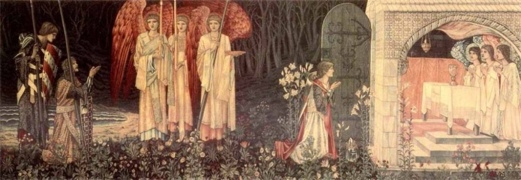“Ask yourself, why do you seek the Cup of Christ? Is it for His glory, or for yours?”
Yesterday I wrote about Raiders of the Lost Ark and about how great it is. But let’s not forget it’s part of a franchise, one of the rare kind where the other films mostly stand up to the original. And, as I was talking about how Raiders is based in Judaism and the Old Testament, today I figured I’d go to the other end of the Bible: step forward Indiana Jones and the Last Crusade and its quest for the Holy Grail.
Only despite the whole Da Vinci Code kerfuffle, there’s a problem. Because the Holy Grail isn’t in the Bible, or at least not in any direct way.
Jesus coins the wine/blood symbolism at the Last Supper but there’s no great description of a Grail, they just use a cup to drink from. Boring and conventional I know, but there you go. No, the Holy Grail is basically a medieval plot device.
See, somewhere between 1181 and 1190, a French poet called Chretian de Troyes wrote Perceval: The Story of the Grail. During the poem, Perceval manages to impress King Arthur, fall in love, meets the Fisher King and has a vision of the Grail. Here it’s an object of power, capable of healing the Fisher King if only Perceval asks the right questions – which he fails to do. It’s nothing to do with the Bloodline of Christ, it’s just the cup that the King’s communion is carried in, important because that’s the only food and drink he’s receiving.
The Grail became holy around a decade later, when Robort de Boron fills in the gaps of its history – Joseph of Arimathea uses the cup from the Last Supper to collect some of Christ’s blood after the crucifixion, eventually making his way to Britain (which links in with an early tradition that had Joseph and a bunch of other minor characters from the Gospels making their way across Europe, as well as being the source of the idea that Jesus once visited England as a boy – cue Jerusalem). None of this really has anything to do with the Bible – effectively it’s New Testament fanfic. Somewhere along the line the Grail became the object of a quest carried out by Arthur and the Knights of the Round Table and it became enshrined in literature as a sacred macguffin.
And in a lot of ways, that’s the Grail’s purpose in The Last Crusade – it’s an excuse to reconcile Indy with his father, and once this happens, the Grail is lost again. However, it’s this story, contrasted with the actions of the film’s antagonists, that shows that Indy is capable of understanding, and experiencing grace.
Look at the film’s bad guy. Donovan is a suave but ruthless businessman obsessed with the Grail and its potential to bring him immortality. To this end he aligns himself with the Nazis and manipulates both of the Joneses; after all, they’re all really just tools to help him live forever. It’s that arrogance, however, that ultimately damns him – when confronted with a roomful of potential Grails, from which he must drink to receive eternal life, he picks the most ornate. He sees the world from a pedestal and the Grail as his prize – of course it’s going to be shiny and jewel-encrusted. But whoops, it’s the wrong one and it ages him to death instead – “He chose…poorly,” the Grail’s guardian wryly comments. Donovan’s Grail quest was all about the prize, not the lessons learned along the way – after all, he never learned them because the other characters did all the work.
Indy, on the other hand, has purer motivations – he just wants to save his dad’s life and go home. And yet because of this, because his quest is noble and involves risking his neck for that of another, Indy is able to succeed. He does his homework (“Jehovah is spelled with an ‘I!'”), he risks his life, and he’s finally able to act with humility and wisdom – he doesn’t want to be a king, he just wants his dad back. “That’s not the cup of a carpenter,” he mutters about Donovan’s false grail, before picking the cheapest and most inconspicuous cup on offer. This is the right choice, because this is the Cup of Christ and the Grail and it’s associated quest reflects this – humility, wisdom, self-sacrifice, reconciliation. The Christian concept of humanity being reconciled back to God is symbolised through the Spielbergian theme of a son’s relationship with his father, and once this happens the Grail is no longer needed – it disappears and its temple collapses, job done, and all that remains for our heroes to do is return home wiser than when they set out.
Heck, even the audience is enlightened in the final moments – we find out that Indy named himself after the family dog.
I guess it’s appropriate that a trilogy (let’s put aside The Kingdom of the Crystal Skull for the moment) that began with Indy confronted by the Wrath of God (in the form of the opened Ark of the Covenant) should end with him encountering God’s grace – judgement and mercy meet around the Easter story in which the Grail myth has its origins. The prodigals return home and a fracture family is reunited. We’ve seen wrath – and melted Nazis – now we get to see healing.
There’s another Indy film after this, of course, but that plays with sci-fi more than it does with myth and somehow it’s weaker for it – it tries to emulate fifties B-movies, but bringing in aliens and Communists (the interchangeable ‘Other’ of films like Invasion of the Bodysnatchers) weakens it somehow – Indy seems to be the detrrmined hero who doesn’t know when to stop even when divine forces are moving around him. It’s that determination and heroism that brings him a measure of healing in The Last Crusade. I’d say he deserved it, but that wouldn’t be grace – Indy’s always been a rough diamond for all his heroism.
But even rogues can sometimes be pilgrims.
[tweetmeme source=”@starmanjack43”]


